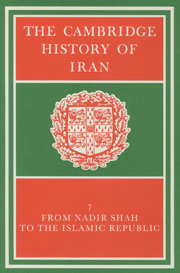Book contents
- Frontmatter
- PART 1 THE POLITICAL FRAMEWORK, 1722–1979
- PART 2 FOREIGN RELATIONS
- PART 3 ECONOMIC AND SOCIAL DEVELOPMENTS
- 13 LAND TENURE AND REVENUE ADMINISTRATION IN THE NINETEENTH CENTURY
- 14 THE TRIBES IN EIGHTEENTH- AND NINETEENTH-CENTURY IRAN
- 15 THE TRADITIONAL IRANIAN CITY IN THE QāJāR PERIOD
- 16 EUROPEAN ECONOMIC PENETRATION, 1872–1921
- 17 ECONOMIC EVELOPMENT, 1921–1979
- 18 THE IRANIAN OIL INDUSTRY
- PART 4 RELIGIOUS AND CULTURAL LIFE, 1721–1979
- Genealogical tables
- Bibliographies
- Index
- References
16 - EUROPEAN ECONOMIC PENETRATION, 1872–1921
from PART 3 - ECONOMIC AND SOCIAL DEVELOPMENTS
Published online by Cambridge University Press: 28 March 2008
- Frontmatter
- PART 1 THE POLITICAL FRAMEWORK, 1722–1979
- PART 2 FOREIGN RELATIONS
- PART 3 ECONOMIC AND SOCIAL DEVELOPMENTS
- 13 LAND TENURE AND REVENUE ADMINISTRATION IN THE NINETEENTH CENTURY
- 14 THE TRIBES IN EIGHTEENTH- AND NINETEENTH-CENTURY IRAN
- 15 THE TRADITIONAL IRANIAN CITY IN THE QāJāR PERIOD
- 16 EUROPEAN ECONOMIC PENETRATION, 1872–1921
- 17 ECONOMIC EVELOPMENT, 1921–1979
- 18 THE IRANIAN OIL INDUSTRY
- PART 4 RELIGIOUS AND CULTURAL LIFE, 1721–1979
- Genealogical tables
- Bibliographies
- Index
- References
Summary
In the course of the 19th century and the first half of the 20th, the foreign economic impact on Iran was far weaker than on its neighbours: India, Transcaucasia, Turkey, Syria, Egypt and, after 1865, Central Asia. A few figures illustrate the difference. In 1913, Iran's foreign trade (exports and imports) per capita was $10, Turkey's $15, Egypt's $24 and India's $4. Foreign capital investment totalled about $150 million, compared to over $1,000 million each in Egypt and Turkey and nearly $2,000 million in India. There were, to all intents and purposes, no railways in Iran, as against some 3,500 kilometres in Turkey, 4,300 in Egypt and 56,000 in India, and practically no modern factories. It may be added that the foreign social and cultural impact — as indicated, for example, by the number of alien residents, foreign schools, books and newspapers published or films shown — was also much weaker in Iran.
Several factors explain this situation. First, there was Iran's geographic isolation: until the opening of the Suez Canal in 1869 it was over 10,000 miles away from Western Europe and 1,500–2,000 miles from the main centres of Russian economic activity; and in the era of sea trade, Iran, unlike its Middle Eastern neighbours, lay off the world's great commercial routes. Secondly there was its physical structure: its inhospitable coast lines, rugged terrain, and the fact that its most fertile and richest provinces are cut off from the open seas by mountain ranges and deserts which, coupled with lack of navigable rivers, inhibited facility of communications.
- Type
- Chapter
- Information
- The Cambridge History of Iran , pp. 590 - 607Publisher: Cambridge University PressPrint publication year: 1991
References
- 1
- Cited by

